

How to use IF function in Excel: examples for text, numbers, dates, blank cells. The IF function is one of the most popular and useful functions in Excel.

What Is the Difference Between Product Backlog Grooming and Sprint Planning? Effective team collaboration in sprint planning is the obligatory condition of a qualitative result.
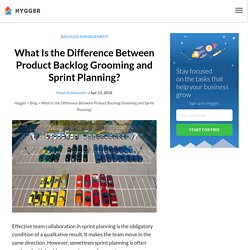
It makes the team move in the same direction. User Stories and Use Cases - Don’t Use Both! ScrumMaster vs scrum master: What do you think? How UX designers and Product Managers can work together. Simple Guide on Creating Flowchart for Switch Statement. There are 3 main types of technical debt. Here’s how to manage them. Which tools do product managers use? Leading a product from conception to completion is no easy task — and product managers deserve their own toolkit.
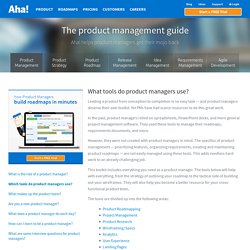
Yet PMs have had scarce resources to do this great work. In the past, product managers relied on spreadsheets, PowerPoint decks, and more general project management software. They used these tools to manage their roadmaps, requirements documents, and more. However, they were not created with product managers in mind. The specifics of product management — prioritizing features, organizing requirements, creating and maintaining product roadmaps — are not easily managed using these tools. This toolkit includes everything you need as a product manager. The tools are divided up into the following areas: Product Roadmapping Aha! Create a visual product roadmap to outline your strategy, features, and ideas. Project Management. Project Management, Agile, Waterfall, and UX Diagrams on Behance.
What are the disadvantages of agile software development? Lonely Planet Travel Guides and Travel Information. We achieve styling through opt in classes and do not style elements globally.
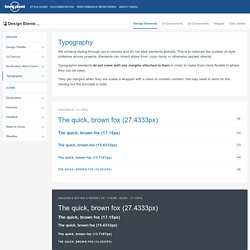
This is to reduced the number of style collisions across projects. Elements can inherit styles from .copy--body or otherwise applied directly. User Stories and User Story Examples by Mike Cohn. User stories are short, simple descriptions of a feature told from the perspective of the person who desires the new capability, usually a user or customer of the system.
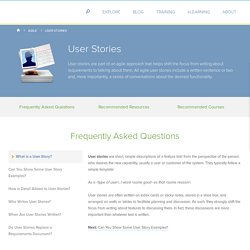
They typically follow a simple template: As a <type of user>, I want <some goal> so that <some reason>. User stories are often written on index cards or sticky notes, stored in a shoe box, and arranged on walls or tables to facilitate planning and discussion. As such, they strongly shift the focus from writing about features to discussing them. In fact, these discussions are more important than whatever text is written. BRD vs. Functional Software Requirements.
We often get the question asking “what is the difference between business requirements and functional requirements?”
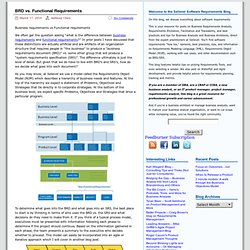
In prior posts I have discussed that these distinctions are actually artificial and are artifacts of an organization structure that requires people in “the business” to produce a “business requirements document (BRD)” vs. some other group that will produce a “system requirements specification (SRS)”. The difference ultimately is just the level of detail. But given that we do have to live with BRD’s and SRS’s, how do we decide what goes into each document? As you may know, at Seilevel we use a model called the Requirements Object Model (ROM) which describes a hierarchy of business needs and features. At the top of the hierarchy we expect a statement of Problems, Objectives and Strategies that tie directly in to corporate strategies. Select – Executives are presented with a number of possible projects with conceptual business cases.
Mapping the Product Manager Role to the Product Owner Role - Scrum Alliance. About Usability - Website Design. A website is a window into how your organization is run.
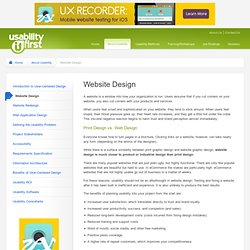
Users assume that if you cut corners on your website, you also cut corners with your products and services. When users feel smart and sophisticated on your website, they tend to stick around. When users feel stupid, their blood pressure goes up, their heart rate increases, and they get a little hot under the collar. This visceral negative reaction begins to harm trust and brand perception almost immediately. Print Design vs.
Everyone knows how to turn pages in a brochure. While there is a surface similarity between print graphic design and website graphic design, website design is much closer to product or industrial design than print design. There are many popular websites that are just plain ugly, but highly functional. How To: Start a Web Design Project. Asurion Online Standards Resource. Technical Design Documentation - Verizon TMP - Confluence. Effort vs. Time. Effort vs.

Time Posted on 16, Nov 2011 When defining a story, one can fill out an ‘effort’ and a ‘duration’. What is the difference between them? Effort = size = Story points Let starts with the story point. When you want to develop some feature, you have to know the „size“ at first. When we are talking about story points, we are talking about the size. How Companies Track People Without Becoming Big Brother. Andre Lavoie is the CEO of ClearCompany, the first talent alignment platform that bridges the gap between talent management and business strategy by contextualizing employees’ work around a company’s vision and goals.
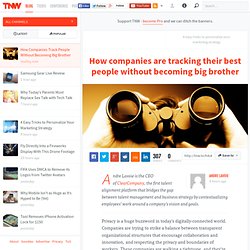
Privacy is a huge buzzword in today’s digitally-connected world. Companies are trying to strike a balance between transparent organizational structures that encourage collaboration and innovation, and respecting the privacy and boundaries of workers. These companies are walking a tightrope, and they’re often falling down. What happens is usually far from organizational transparency and closer to micromanagement.
Instead of having sight lines into the workflow of your team, companies become Big Brother and put tight structures in place with the hope of cracking down on time-wasters and improving productivity. Scrum Effort Estimation and Story Points. Posted by admin under Scrum Basics In waterfall, managers determine a team member’s workload capacity in terms of time.

That is, managers estimate how long they anticipate certain tasks will take and then assign work based on that team member’s total available time. This is problematic because it does not distinguish between a story that is very hard to complete and one that is undemanding; it only considers how long the work will take. To put it another way, coding a feature and organizing the heaps of documentation on your desk are activities that likely take the same amount of time, but there’s no question that the former would require much more sustained concentration and effort.
Because of that fact, they should be recognized as incredibly different tasks, requiring different levels of effort. Scrum takes a considerably different approach to determining a team member’s capacity. Scrum Sprint Planning Meeting. Posted by admin under Scrum Basics Sprint Planning Meeting In Scrum, every iteration begins with the sprint planning meeting. At this meeting, the Product Owner and the team negotiate which stories a team will tackle that sprint.
Scrum Meeting Schedule - Two-Week Sprint. So, you’ve heard about Agile and Scrum, your company is sold into the benefits, you’ve had your Scrum Master training, you’re good to go… and now you need to set up all of the meetings! This post will give you a simple overview of the Scrum Meetings and some suggestions for how you might like to schedule/run them. I’ll base this post on a two-week sprint as this seems to be the most common within the Digital Publishing industry. The agendas and the logic behind the scheduling order remain the same regardless of the sprint duration, however the length of time invested in meetings will vary (it should always be kept to a minimum – no more than 10% of the sprint effort). Day 1 of the Sprint Sprint Planning Meeting: Sprint planning is split into two parts. The first part is attended by the full team Product Owner and the Product Manager – this is when the product owner presents the highest priority backlog items to the team – there is a Q&A to ensure that requirements are understood.
Daily Scrum. Scrum Alliance -Perfect PlanningBest Practices for Successful Sprint Planning. A successful sprint starts with the planning session. Taking the time to plan allows the team to review the work about to be undertaken, estimate the effort required to complete that work, and then commit to a prioritized list of stories and tasks that are within the team’s calculated capacity. This light set of procedures is well documented in Scrum and Agile literature [1],[2], but included here are some observable traits and best practices that have been found in well-formed, hyper-productive agile teams.
The purpose of the agile planning session is to present a collection of user stories to the team and allow them to be estimated. This is where team effort gets aligned with business direction, and is the essence of the agile phrase, “let the product lead.” Scrum Sprint Planning Meeting. How to Create Products that Customers Hate. 5 Flares Filament.io 5 Flares × The following list is a tongue-in-cheek collection of common mistakes in applying Scrum. They all influence product success negatively. Combined they are a recipe for certain failure. Lean UX: Getting Out Of The Deliverables Business. Advertisement User experience design for the Web (and its siblings, interaction design, UI design, et al) has traditionally been a deliverables-based practice.
Wireframes, site maps, flow diagrams, content inventories, taxonomies, mockups and the ever-sacred specifications document (aka “The Spec”) helped define the practice in its infancy.